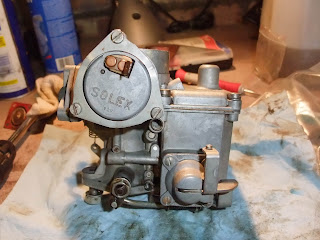A couple of posts ago I'd removed the oil pump from the crankcase. This was the last step before splitting the crankcase. I removed all the fasteners - there were many...
The bottom of this picture is the back of the engine (pulley) and the top is the front (flywheel). The small fasteners around the edge make the case oil tight and the six bolts in the middle ensure the crankshaft is secure.
I had the engine attached to my stand with three bolts - two in the left hand side and one in the right hand side. Before splitting the case the right hand side bolt was removed. I was pleased that the whole engine didn't fall on the ground at this point.
Next I worked round the case lightly hammering on a piece of wood to try and get the right hand case moving. Initially the only gap that appeared was at the old cooler. There was no sign of movement at the flywheel end at all. I noticed went round the seam removing any signs of sealant and sprayed liberally with WD40. I repeated the this hammering and spraying cycle a couple of times a few days apart - by which time the flywheel seam had opened about 0.5mm. Today I did the same again and the WD40 had clearly done its job as the right hand case came off almost immediately. The following photographs show each half.
The crankshaft and camshaft should simply lift out of the left hand case. Then I need to remove the oil pressure relief value and start the cleaning process. The plan is to start on the right hand side by scraping out the bulk of the joilly before bathing the case in solvent (probably white spirit as it's reasonably cheap). I'll then repeat as often as necessary and blow compressed air through the oil channels. Then repeat on the other side. In my future I see many trips to the dump with cans full of an unpleasant smelling black liquid.
Monday, 19 August 2013
Sunday, 18 August 2013
Carburettor Rebuild
The carburettor rebuild was pretty straight forward. I didn't remove either throttle as they both moved easily. However I did spend a lot of time withe carburettor cleaner removing all the black deposits that had built up over the years - as shown on the following images.
The final photograph shows all the rust and sediment that had collected in the float chamber. This was actually quite difficult to shift, I had to resort to scraping it off with a screwdriver. Another area that was particularly cruddy was the chamber the accelerator diaphragm covers. It looked like some sort of reaction had taken place but after a bit of scraping it turned out to be much worse than it looked. Importantly the sealing surface was smooth and so I don't think it will leak fuel (though only time will tell).
After thoroughly cleaning everything I checked that all the channels and tubes were clear using compressed air. Then I put everything back together with new diaphragms, gaskets etc. The following shots show the final result - not gleaming but quite acceptable.
Subscribe to:
Comments (Atom)







